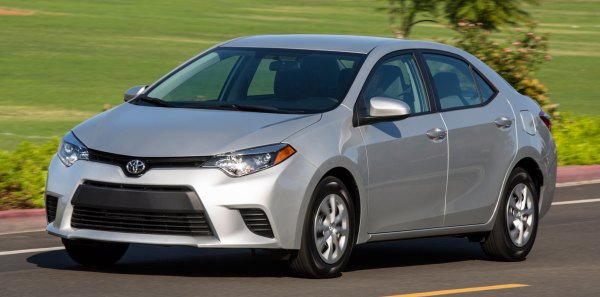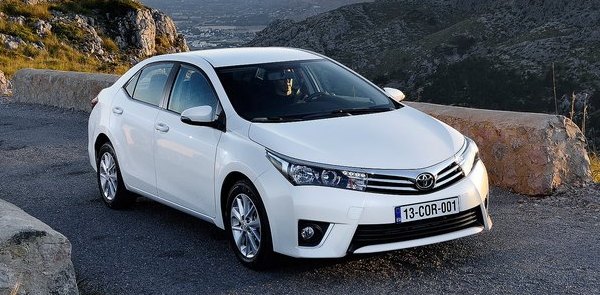|
|
|
Published
on 16
Sep 2013
|
All rights reserved.
|
|
|

US
version Corolla
|
Globalization has
become the industrial norm during the past decade. Many manufacturers
that used to build different cars for different continents turned to
unite their offerings globally in order to reduce cost. The money saved
can be put into the development program again, to add contents or to
upgrade build quality. The results are better products and higher
competitiveness. Globalization has its drawbacks though. You can't
satisfy the conflicting requirements of different markets. If the
conflicts get too big, you are likely to lose the favour of one or more
markets. Now Toyota finds it face this situation with Corolla. While
the domestic market increasingly favours small cars, overseas markets,
especially America and China, has been shifting to larger "compact"
cars (they are redefining the word "Compact" every day). For example,
Hyundai Elantra, Kia Forte, Nissan Sentra and Dodge Dart have their
wheelbase stretched to 2700 mm, while Honda Civic is not far away at
2670 mm. Their body widths have long exceeded 1700 mm, which would fall
into a higher tax band in Japan. In the last generation (Mk10) Corolla,
Toyota deliberately made the overseas version wider than the domestic
version, but this alone failed to answer all the criticisms of
overseas buyers, especially about the lack of rear seat legroom. This
time around, it simply splits the domestic and overseas versions into
different platforms.
While the Japanese Corolla is built on the smaller B-segment platform
that underpins Vitz (Yaris) and Ractis, the overseas version sits on
the larger MC-platform that gave birth to the old car as well as Prius,
Auris, Lexus CT, Avensis, Sai (Lexus HS), Scion tC etc. Unsurprisingly,
it rides on a 2700 mm wheelbase like most of these cars. The larger
platform also enables the body width to be stretched to 1775 mm.
Compare with the Japanese version, it is 280 mm longer and 80 mm wider
overall. The extra 100 mm wheelbase allows a near class-leading rear
legroom. Now a passenger of 6 feet 4 inches tall can sit behind a
driver of the same size, a sharp contrast to the old car!
Now you might question what a Corolla really is. If Toyota can badge
two practically different cars the same name, then we will have no
doubt that the Corolla will continue to be the world's best selling car
for… probably forever! Just like the increasingly misused "Prius"
nameplate, one day we might see the Corolla name to appear on half a
dozen models with no relationship, just to make up the numbers!

European
version
|
Yes, the World version is very different from the domestic model, not
just dimensionally but also the exterior design. It looks much sharper
and sportier. There are virtually no genes shared with the Japanese
car, which is a good thing actually. Although it is still not exactly a
beautiful design, I would say it is a lot more interesting, washing
away the dullness and conservatism that we used to perceive about
Corolla.
The American version and European version differ in nose and tail
design, but otherwise they are the same car. Their 2.5-box profile,
achieved by a shorter trunk and faster rear screen, should appeal more
to European customers.
Inside, the dashboard is clearly donated by Auris. Its design is a lot
less convincing than the exterior. The center console looks a mess and
the plastics are not exactly top-notch compared with most European
rivals. The interior looks dark and boring. Fortunately, there is an
easy-to-use infotainment system to save the game. You can download Apps
to add gadgets. The amount of space is impressive, as is the trunk. The
front seats are much improved from the old car's, being more supportive.
Despite of the spiced-up exterior, the car remains as boring to drive
as before. Two words sum it up: Slow and Numb.
We don't expect a compact family sedan to be a hot hatch, but still,
the Corolla's average engines do not haul the relatively heavy car with
the enthusiasm you would find in a Golf or Focus. In America, Toyota
offers either a 132 hp 1.8-liter Dual-VVT-i or 140 hp 1.8-liter
Valvematic engine. Both lack low-down torque and needs to be revved
hard. The Valvematic is best to be seen as the equivalent of
Valvetronic instead of VTEC, serving to save fuel rather than enhancing
power. You won't feel the extra 8 ponies on the road, no wonder Toyota
installs it into the "Eco" model and pairs with CVT only. Both engines
take more than 9 seconds to do 0-60 sprint. By American standard, that
is really slow.
A 6-speed manual is served, but by far most buyers will choose the new
CVT. It has 7 simulated ratios operated via paddles. Like Nissan's
Xtronic CVT, it is as good a CVT can get, being reasonably refined and
intelligent unless you prefer an aggressive driving style (note: Toyota
obviously think you don't).
In Europe, the engine options includes 90hp 1.4D-4D turbo diesel, 99 hp
1.33 Dual-VVT-i, 122 hp 1.6 Dual-VVT-i, 132 hp 1.6 Valvematic and 140
hp 1.8 Dual-VVT-i. This mean performance is no better than the American
version.
Slow aside, the Corolla is not a bit interesting to drive. Its
electrical power steering serves better than others to filter all kinds
of road feel. It feels numb on-center. Its feels numb all the way to
locks. You have no idea what the front wheels are doing and when they
are going to give up. Moreover, the assistance is not consistent, thus
you need constant correction during cornering. It is hard to name a
worse steering in recent memory.
The NVH is definitely improved, and the chassis feels more solid, just
like most new rivals. However, the handling does not match the class
average, let alone the high standard set by the likes of Focus, Golf or
Giulietta. The 215/45R17 tires generate less grip than you would expect
for their size. They give up early and the car tends to understeer. The
body rolls noticeably if you press the car in corner, blame to the
relatively soft suspension setting. The brakes on most models still
rely on drums at the back, no wonder braking performance is poor. In
terms of driving dynamics, the Corolla can be rated near the bottom of
the class, at least among the key players.
Space and exterior styling aside, the Corolla doesn't have many
strengths to offset its vast array of weaknesses. Yes, some people
don't care about driving pleasure, but with so many better and more
versatile rivals to choose from, there is little point to choose the
Toyota – unless you are proud to own the world's best selling car.
|
Verdict:   |
|
|
|
|
|
|
|
|
|
|
Corolla
(US) 1.8
|
2013
|
| Front-engined,
FWD |
| Steel monocoque |
| Mainly steel |
| 4640 / 1775 / 1455 mm |
| 2700 mm |
Inline-4
|
| 1797 cc |
DOHC 16 valves, DVVT
|
| - |
| - |
132 hp
|
128 lbft
|
CVT or 6-speed manual
|
F: strut
R: torsion-beam
|
-
|
| 215/45R17 |
1270 kg (6M) / 1295 kg (CVT)
|
6M: 124 mph (est)
CVT: 118 mph (est)
|
6M: 9.0 (est)
CVT: 9.5* / 9.7**
|
CVT: 28.7*
|
|
Corolla
(US) 1.8 Valvematic
|
2013
|
| Front-engined,
FWD |
| Steel monocoque |
| Mainly steel |
| 4640 / 1775 / 1455 mm |
| 2700 mm |
Inline-4
|
| 1798 cc |
DOHC 16 valves, DVVT, VVL
|
| - |
| - |
140 hp
|
126 lbft
|
CVT
|
F: strut
R: torsion-beam
|
-
|
| 205/55R16 |
1295 kg
|
120 mph (est)
|
9.5*
|
27.1*
|
|
Corolla
(EU) 1.6 Valvematic
|
2013
|
| Front-engined,
FWD |
| Steel monocoque |
| Mainly steel |
| 4620 / 1775 / 1465 mm |
| 2700 mm |
Inline-4
|
| 1598 cc |
DOHC 16 valves, DVVT, VVL
|
| - |
| - |
132 hp
|
118 lbft
|
| CVT or 6-speed manual |
F: strut
R: torsion-beam
|
-
|
| 205/55R16 |
1250 kg (6M) / 1270 kg (CVT)
|
6M: 124 mph (c)
CVT: 118 mph (c)
|
6M: 9.4 (est)
CVT: 10.4 (est)
|
-
|
|
|
|
|
|
Performance
tested by: *C&D, **MT
|
|
|
|
|
|
|
|
|
Copyright©
1997-2013
by Mark Wan @ AutoZine
|
|